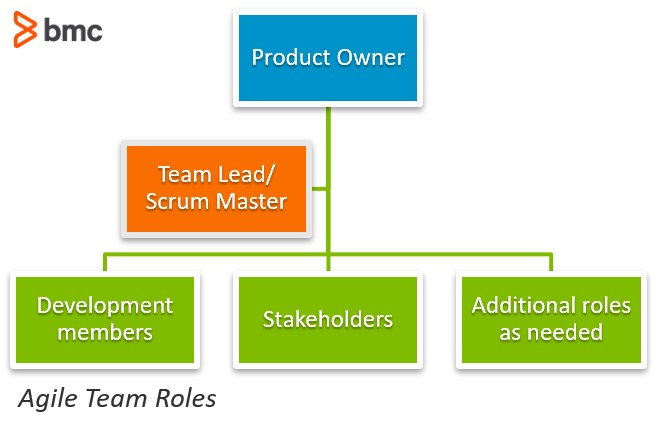Agile Roles & Responsibilities


The Agile software development lifecycle (SDLC) was developed with a clear goal: rapid delivery of software builds through an incremental and iterative process designed to adapt and improve software quality from an end-user perspective. The goal is readily adopted by IT departments and shops, though the process framework is not always adequately adopted.
 Organizations adopting an Agile approach may find themselves resorting to traditional/waterfall SDLC practices due to inappropriate distribution of Agile roles and responsibilities. So, let's take a look at the roles that support Agile software development.
Organizations adopting an Agile approach may find themselves resorting to traditional/waterfall SDLC practices due to inappropriate distribution of Agile roles and responsibilities. So, let's take a look at the roles that support Agile software development.
This article explores the roles and responsibilities within the Scrum framework for Agile implementation. Some key differences in Agile team building exercise include:
Agile teams are often comprised of the following key roles and responsibilities:
 Let's take a look at each.
Let's take a look at each.
The product owner represents the stakeholders of the project. The role is primarily responsible for setting the direction for product development or project progress.
The Product Owner understands the requirements of the project from a stakeholder perspective and has the necessary soft skills to communicate the requirements to the product development team. The Product Owner also understand the long-term business vision and aligns the project with the needs and expectations of all stakeholders. End-user feedback is taken into account to determine appropriate next-best action plans for the development throughout the project cycle.
The key responsibilities of a Product Owner include:
The Product Owner is knowledgeable of the backlog items added to the list as well as items selected for work. The Product Owner changes and sets the priority of backlog item list based on stakeholder feedback and project circumstances. The role also manages the release cycle planning to ensure that the development team can deliver updated project iterations on a continuous basis.
Finally, the Product Owner ensures that product development translates into value for the stakeholders. Communication with end-users, business executives, partners and the development team is therefore a key responsibility.
The Team Lead or Scrum Master ensures team coordination and supports the progress of the project between individual team members. The Scrum Master takes the instructions from the Product Owner and ensure that the tasks are performed accordingly.
The role may involve:
The role is also responsible to manage external coordination with the organization and the Product Owner to ensure effective implementation of the Scrum framework. The responsibilities may include:
The role of a Scrum Master is focused on attributes such as transparency across the Scrum Team, self-organization, commitment, respect and most importantly, following an empirical process to identify the best approach for product development.
The team members within the Development Team are comprised of individuals with responsibilities including but not limited to product development. The team takes cross-functional responsibilities necessary to transform an idea or a requirement into a tangible product for the end-users. The required skills might be wrapped up in one or more dev team members:
Not every member may be an engineer but may be a part of the team if their skills are required for the project to proceed at the required pace.
In addition to the skills facilitating product development, the team members should also have soft skills that enable them to self-organize and get the work done. This means that when an issue occurs, the team is both capable and empowered to take corrective actions.
The key responsibilities of the Development Team is to perform work sprints as per the requirements provided by the Product Owner and coordinated by the Scrum Master. A regular standup meeting called the Daily Scrum is followed to communicate project progress with the peers and the Scrum Master. This activity ensures transparency and allows the Development Team to incorporate the changes as necessary in future sprints based on feedback from the Product Owner.
The Stakeholder position may not be directly involved in the product development process but is used to represent a range of key roles that impact the decisions and work of the Scrum team. The stakeholder may be:
Input from the Stakeholders is key to direct the progress of the project in different directions to align product development with business goals, end-user expectations as well as addressing challenges facing the Scrum Development Team.
The Agile project manager role brings project management skills and practices to Agile projects. Rather than focus on sticking to rigid plans and schedules, Agile project managers focus on promoting effective collaboration and facilitating quick adaptation to serve customer needs and deliver value.
Typical responsibilities include:
Agile project managers need to have mastery of Scrum and other Agile frameworks. They have to be comfortable managing through constant change in dynamic environments, where priorities constantly shift. As leaders, they encourage cooperation, keeping communication open and working to identify and solve problems quickly.
Agile integrators keep it all together. People in this role ensure everything meshes, from collaboration within and between teams, to systems, to staying aligned around business objectives—all within the Agile framework. They implement Agile practices throughout an organization and ensure that external teams and systems seamlessly integrate. The role is particularly vital in complex projects, projects involving many teams, and where systems are complicated.
Implementing an Agile framework at scale requires an Agile integrator to have numerous skills, such as:
The role of Agile integrator is similar to that of an Agile project manager. The roles have significant overlapping responsibilities, making a dual role feasible for smaller organizations and projects that are not particularly complex. That said, there are nuances between the two.
Agile integrators have a broader scope of responsibility in most organizations, while Agile project managers are tasked to specific projects. An Agile integrator is more involved in making sure everything works together, while the project manager is focused on outcomes. Agile integrators also need more extensive technical knowledge with expertise in integration platforms and DevOps tools.
In addition to these typical roles of the Scrum team, large enterprises working on large projects may include more roles into the Scrum teams. These can include:
In summary, the roles in the Agile methodology and specifically the Scrum framework should be seen from the perspective of responsibilities. These roles don’t reflect job titles and should not be treated as such. The Scrum responsibilities should be distributed among existing team members assigned with the tasks to follow project management activities as well as technical issues using the Agile principles.
The term “Agile ceremonies” refers to the vital meetings that take place within Agile frameworks. Ceremonies are formal, structured meetings for planning, testing, inspecting, and staying aligned.
Typical Agile ceremonies include:
Each Agile team member works in harmony with the others for the open communication and smooth collaboration necessary for flexible and agile delivery. Familiarity with the Responsibility, Accountability, Consulting Source for Expertise, and Informed Parties (RACI) Matrix for the project ensures that all team members understand the overall process, responsibilities, and status.
The adoption of Agile practices is transforming how businesses operate, making them more responsive and efficient while innovating and pleasing customers in a fast-changing and highly competitive world.
On the organization or business side, benefits include:
Individuals benefit as much as their organizations. Individual team members are empowered with a sense of ownership regarding their roles, their output, and decision making. With clear goals and priorities, and an open and collaborative culture, employees know what is expected, learn from each other, and build strong relationships. That, in turn, fosters continuous learning and skill building for a rewarding career with less stress and risk of burnout.